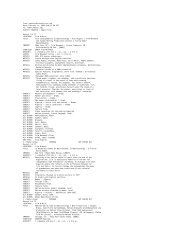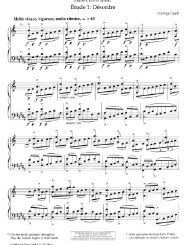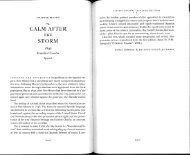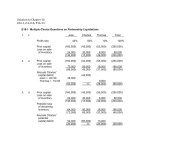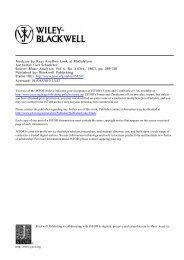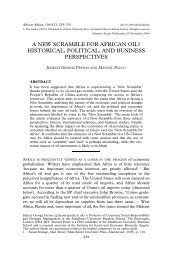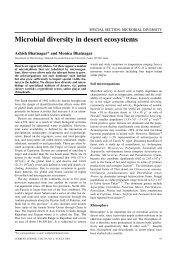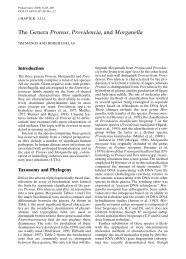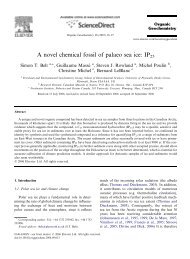The Genus Serratia
The Genus Serratia
The Genus Serratia
You also want an ePaper? Increase the reach of your titles
YUMPU automatically turns print PDFs into web optimized ePapers that Google loves.
234 F. Grimont and P.A.D. Grimont CHAPTER 3.3.11<br />
Table 5. Identification of species in the <strong>Serratia</strong> liquefaciens complex. a<br />
Characteristic<br />
S. liquefaciens<br />
Clab<br />
a Symbols as in Table 4.<br />
b <strong>The</strong> type strain of S. proteamaculans (ATCC 19323) corresponds to biotype C1c.<br />
c <strong>The</strong> type strain of S. grimesii (ATCC 14460) corresponds to biotype C1d.<br />
<strong>The</strong> potato-like odor produced by S. odorifera, S. ficaria, and a few strains of S. rubidaea, was identified as a pyrazine<br />
(3-isopropyl-2-methoxy-5-methylpyrazine) (Gallois and Grimont, 1985).<br />
scens, 4 in S. proteamaculans, 2 in S. grimesii, 3<br />
in S. rubidaea, 2 in S. odorifera, and 2 in S. entomophila.<br />
Characteristics of these biotypes are<br />
given in Tables 6–9. Carbon source utilization<br />
tests are major elements in the identification of<br />
these biotypes. Multipoint inoculation devices<br />
(e.g., Denley Multipoint Inoculator, Denley<br />
Instruments, Ltd., Bolney Cross, Bolney, Sussex,<br />
England), are the most useful for biotyping 20 or<br />
more strains at a time. Biotype identification is<br />
faster (1–4 days) when API strips containing carbon<br />
sources are used. Alternatively, filter paper<br />
disks impregnated with each carbon source can<br />
be deposited on an inoculated minimal agar<br />
S. proteamaculans<br />
subsp. proteamaculans<br />
subsp. quinovora<br />
S. grimesii<br />
C1c RQ<br />
b EB RB C1dc ADC<br />
Growth on:<br />
trans-Aconitate − + + − + − +<br />
Adonitol − − (+) − − − −<br />
Benzoate − − (+) v − + −<br />
m-Erythritol − − + − − − −<br />
Gentisate − − − + − − −<br />
D-Malate + − − − v (v) (v)<br />
L-Rhamnose − − − + d − −<br />
m-Tartrate + − − − d − −<br />
Arginine decarboxylase − − − − − + +<br />
Esculine hydrolyzed + + + + − + +<br />
Table 6. Identification of <strong>Serratia</strong> marcescens biotypes. a<br />
Characteristic<br />
a Symbols as in Table 4.<br />
b Growth on D-malate and meso-tartrate is correlated with growth on DL-carnitine (Grimont, unpublished observations).<br />
c Lactose-positive strains are occasionally isolated.<br />
d Nonpigmented strains are occasionally isolated.<br />
Biotype<br />
A1 A2 A6 A3 A4<br />
a b a b a a b c d a b A5 a b c<br />
A8<br />
(Sifuentes-Osornio and Gröschel, 1987). Differentiation<br />
between S. proteamaculans biotypes<br />
Cla and Clb is superfluous; electrophoresis of<br />
proteinases (Grimont et al., 1977a) could not discriminate<br />
between these two biotypes.<br />
Serotyping of <strong>Serratia</strong> marcescens<br />
TCT TC TT<br />
Growth on:<br />
m-Erythritol + + + + + + + + + + + − − − − − − −<br />
Trigonelline − − − + − − + − + − − + + + + + − +<br />
Quinate and/or 4-hydroxybenzoate − − − − + − − − − + − + + + + − − −<br />
3-Hydroxybenzoate − − − − − + + − − − − − − + − − − −<br />
Benzoate + + − − − − − − − − − − − − − − − −<br />
D-Malate/m-tartrate b + − + + v − − v − + + + v − − + + −<br />
Gentisate − − + + + + + v − + + − v + v − − −<br />
Lactose − − − − − − c − − c − c − c − − c − − c + − c − c −<br />
Tetrathionate reduction + + + + + + + + + − − + + + + + + +<br />
Red pigment + d + d + + + d − − − − − − − − − − − − −<br />
<strong>The</strong> systematic inventory of somatic (O) antigens<br />
of S. marcescens began in 1957 (Davis and<br />
Woodward, 1957). Flagellar antigens (H) were<br />
described (Ewing et al., 1959) and an antigenic<br />
scheme was developed (Ewing, 1986; Ewing et<br />
al., 1959; Le Minor and Pigache, 1977, 1978; Le



